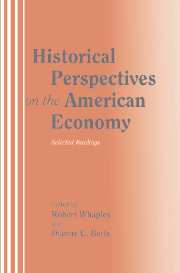Book contents
- Frontmatter
- Contents
- Acknowledgments
- Introduction to students
- Introduction to instructors
- Contributors
- I Introduction
- II Colonial and early national economy
- III Slavery and servitude
- IV The South since the Civil War
- V The rise of American industrial might
- VI Populism
- VII Women in the economy
- VIII The Great Depression
- Appendix: Basics of regression
- Glossary
- Name index
- Subject index
IV - The South since the Civil War
Published online by Cambridge University Press: 05 June 2012
- Frontmatter
- Contents
- Acknowledgments
- Introduction to students
- Introduction to instructors
- Contributors
- I Introduction
- II Colonial and early national economy
- III Slavery and servitude
- IV The South since the Civil War
- V The rise of American industrial might
- VI Populism
- VII Women in the economy
- VIII The Great Depression
- Appendix: Basics of regression
- Glossary
- Name index
- Subject index
Summary
“The trap of debt peonage”
by Roger L. Ransom and Richard SutchAt the end of the Civil War, the southern economy was in disarray. With the abolition of slavery, large-scale agriculture was no longer profitable. Former slaves sought to control their own lives and preferred to work their own farms. By 1868, arrangements arose whereby much of the plantation land was divided into single-family plots to be farmed by tenants. By 1880 about 80 percent of black farm operators in the Cotton South were tenants, and over two-thirds of these tenants were sharecroppers. In addition, about one-quarter of white farm operators were sharecroppers (Ransom and Sutch, 1977, 84). Under the system of sharecropping, the landowner provided almost all materials of production, housing, and land in exchange for one-half of the tenant's output. This approach provided access to land and capital and an opportunity for individual initiative for poor farmers.
Many sharecroppers could not afford to purchase food and other supplies before they harvested their crops. To solve the problem, they borrowed against their future share of the crop at a nearby country store. This arrangement arose, in part, because the Civil War had destroyed much of the South's banking and financial institutions. This left rural areas without complete financial services. Rural merchants, then, became a major source of credit, providing tenant farmers with food, clothing, and other essentials until their crops could be harvested.
- Type
- Chapter
- Information
- Historical Perspectives on the American EconomySelected Readings, pp. 257 - 259Publisher: Cambridge University PressPrint publication year: 1995

